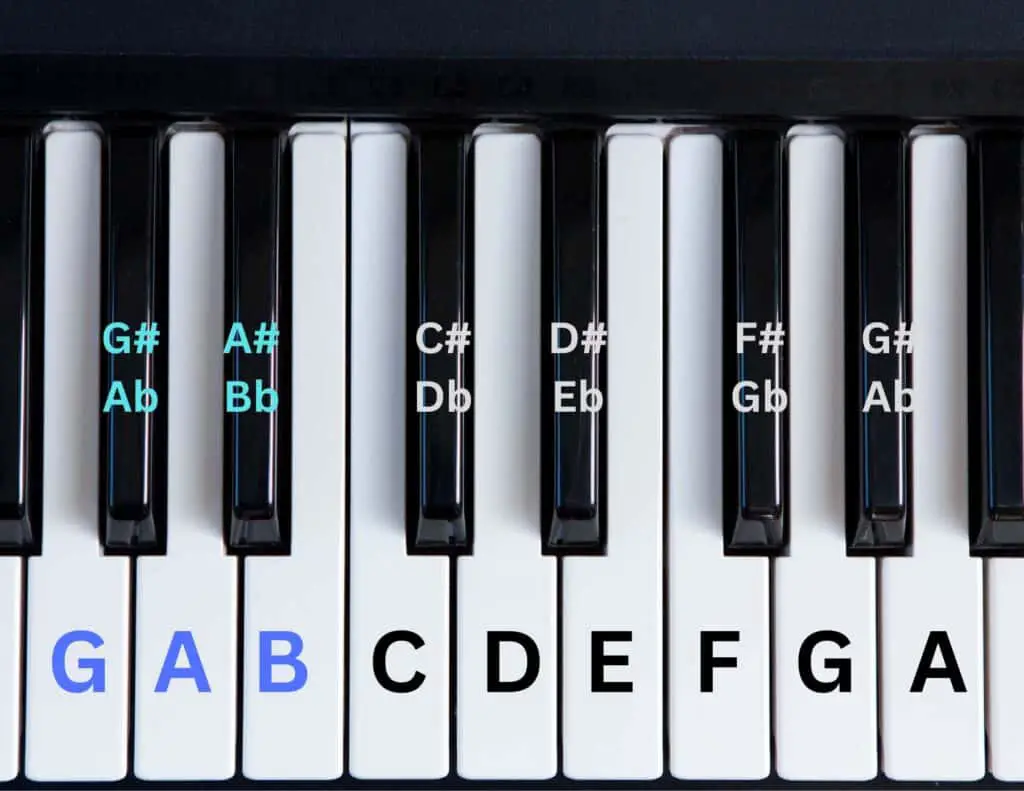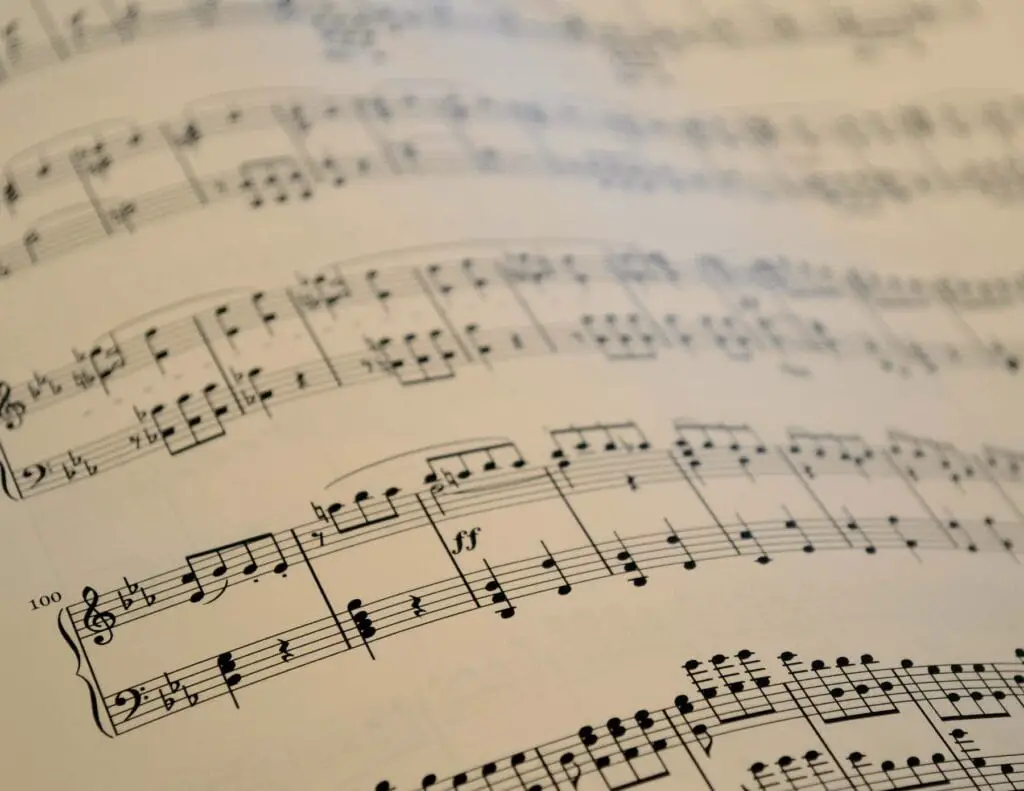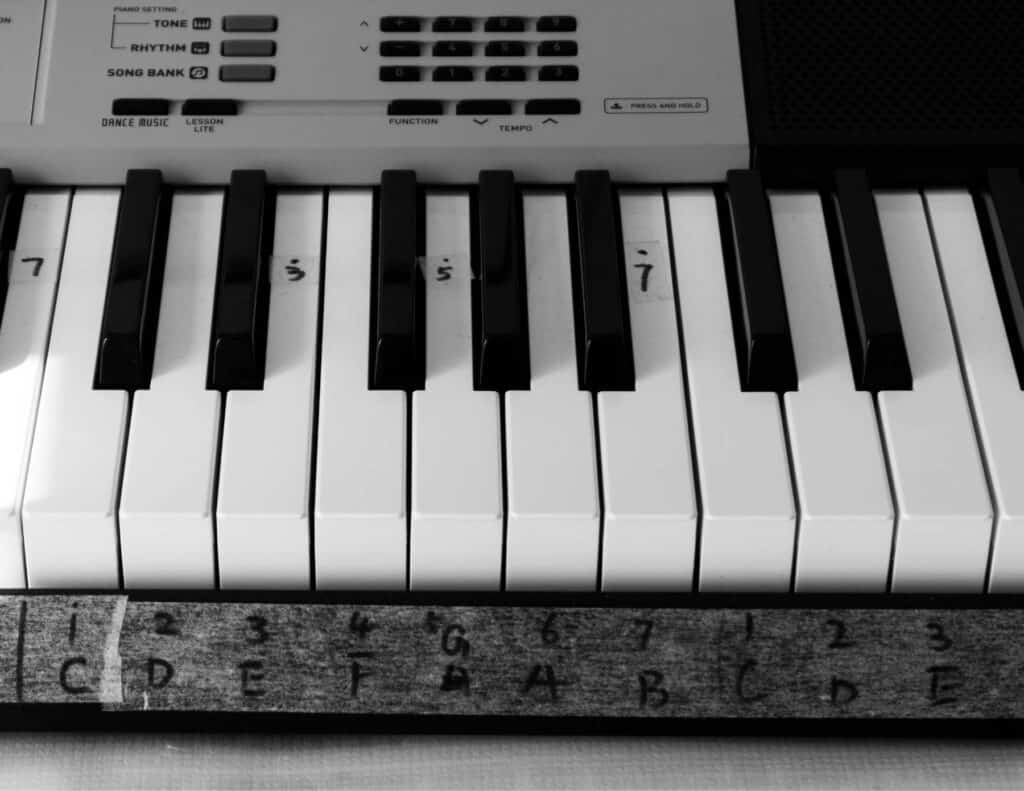
It can be overwhelming for beginners to identify the keys on a piano keyboard, especially when they are not familiar with the musical notes. On trick to help ease a new player into learning to play is to label piano keys to help them see the repeating pattern of notes spread over the 88 keys on a typical piano.
A standard piano keyboard has 88 keys, including 52 white keys and 36 black keys. The keys are arranged in a specific pattern, with groups of two and three black keys alternating with groups of white keys.
In this article, I will cover various ways to label piano keys and how to introduce new players into the basic notes of the white keys and the slightly more complex black keys. I’ll also cover a little on chords and if labeling piano keys will do more harm than good. Just learning where the notes on a piano are is a great way to start practicing, even if you aren’t sitting at the piano.
Key Takeaways
- Understanding the basics of a piano keyboard is essential to label the keys.
- The musical alphabet consists of seven letters and repeats itself as you move up and down the piano keyboard.
- Labeling the piano keys is an important step towards learning to play the piano.
How do you Label Piano Keys?
One way to label piano keys is to use a marker or dry-erase pen to write the note names on the keys. This method is easy and inexpensive, but it can be difficult to remove the writing. Another way is to use colored stickers or pre-printed labels to mark the keys. These labels are inexpensive and can be removed easily.
For those who want a more permanent labeling solution, there are readymade piano stickers available that can be placed on the keys. These stickers are designed specifically for piano keys and are available in a variety of styles and colors. They are also relatively easy to remove if necessary.
Regardless of the method used, it is important to label piano keys in a way that is clear and easy to read. Color-coded labels can be helpful for those who are learning to read sheet music, as they can help to identify the notes quickly and easily. It is also important to label only the keys that are necessary, as labeling too many keys can be overwhelming and confusing for beginners.
Table of Contents
Understanding the Basics of a Piano Keyboard
A piano keyboard is a set of keys that are played to produce musical notes. It is made up of black and white keys that are arranged in a specific pattern. The white keys are called natural keys, and the black keys are called accidental keys.
The pattern of the keys on a piano keyboard is repeated throughout the instrument. The pattern consists of sets of two black keys and sets of three black keys, separated by groups of white keys.
The white keys are labeled with the letters A through G. The black keys are labeled based on their position relative to the nearest white key, marked with a flat (b) or sharp (#).
The note C is an important note on the piano keyboard. It is located to the left of a set of two black keys, in the center of the keyboard. This note is called middle C, and it is used as a reference point for labeling the other keys on the keyboard.
Different types of pianos have different numbers of keys. The most common type of piano has 88 keys, while smaller pianos may have as few as 61 keys. The keys on a piano are weighted to provide a more realistic playing experience.
When you label piano keys, it is common to start with middle C and then label the other keys based on their position relative to middle C. The white keys are labeled with their corresponding letter, while the black keys are labeled with their corresponding letter followed by a sharp or flat symbol.

Identifying the Musical Alphabet on Piano
When learning to play the piano, one of the first things to master is identifying the musical alphabet. The musical alphabet consists of the letters A, B, C, D, E, F, and G. It is important to memorize these letters as they are the foundation of all piano notes.
The layout of a piano keyboard makes it easy to identify the musical alphabet. The white keys on the piano represent the letters A through G in alphabetical order. The pattern of the musical alphabet repeats itself after G, with the next white key being another A.
It is important to note that there is no H in the musical alphabet. After G, the pattern simply repeats itself with another A.
To memorize the musical alphabet on the piano, it can be helpful to use a key chart or musical notation. A key chart is a visual representation of the piano keyboard and the corresponding notes. Musical notation uses symbols to represent the different notes and their duration.
Another helpful tool for identifying the musical alphabet on piano is to use labeled stickers or markers on the keys. This can be particularly useful for beginners who are still learning to read sheet music and identify the different notes.
Learning About Sharps and Flats
Sharps and flats are important concepts to understand when you start to label piano keys. A sharp (#) is used to indicate that a note should be played one half-step higher than its natural pitch, while a flat (b) indicates that a note should be played one half-step lower than its natural pitch.
For example, F# (F sharp) is played by pressing the black key immediately to the right of F, while Gb (G flat) is played by pressing the black key immediately to the left of G. You may have noticed that you just played the exact same key, this is because mechanically they are the same key, but musically they are different notes (called enharmonic.)
To reiterate, some notes have enharmonic equivalents, which means they can be written in different ways but sound the same. For example, F# and Gb are enharmonic equivalents, as are C# and Db, and D# and Eb.
When you label piano keys, it is vital to understand the relationship between sharps and flats and their corresponding notes. A helpful tip is to remember that a sharp note is always one half-step higher than its natural pitch, while a flat note is always one half-step lower than its natural pitch.
In addition, it is important to understand the concept of half-steps, which refers to the distance between two adjacent keys on the piano. Each half-step represents a difference in pitch, which can be altered by using sharps and flats.
Understanding Piano Chords
Piano chords are a group of notes played together to create a harmonious sound. They are an essential part of piano playing and are used in various genres of music, including classical, jazz, and pop. Understanding piano chords is crucial for anyone who wants to play the piano.
A chord consists of at least three notes played together. The most common chords used in piano playing are triads, which consist of three notes played simultaneously. Triads are made up of the root note, the third note, and the fifth note of a scale. For example, a C major triad consists of the notes C, E, and G.
There are different types of chords, including major chords, minor chords, diminished chords, and augmented chords. Major chords have a happy and bright sound, while minor chords have a sad and melancholic sound. Diminished chords have a tense and unstable sound, while augmented chords have a bright and intense sound.
To create chords, you need to know the notes on the piano keyboard. A standard piano keyboard has 88 keys, 52 of which are white and 36 of which are black. The white keys represent the natural notes, while the black keys represent the sharps and flats.
Learning to label piano keys is an important step in understanding piano chords. You can use stickers or markers to label piano keys with their corresponding notes.
Once you have labeled the keys, you can start building chords by playing the root note, the third note, and the fifth note of a scale together.

Reading Piano Sheet Music
Before attempting to read any piano sheet music, there needs to be a clear understanding of what all of those black and white keys mean. The black and white keys represent all of the different tones of the piano. Each key is a note, and when you press a key, you produce a sound. The sheet music tells you which keys to press and when to press them, so it is essential to understand how to read sheet music.
Sheet music is written on a staff, which is made up of five lines and four spaces. The staff is used to represent the different pitches of the notes in the music. The notes are placed on the staff, and their position on the staff indicates the pitch of the note.
There are two types of clefs used in piano sheet music: treble clef and bass clef. The treble clef is used to represent higher-pitched notes, while the bass clef is used to represent lower-pitched notes. The notes on the staff are placed differently depending on which clef is used.
When reading sheet music, it is important to understand the different symbols used to represent the notes. Each note has a specific duration, and this is indicated by the shape of the note. For example, a whole note lasts for four beats, while a quarter note lasts for one beat.
It is also important to understand the different symbols used to indicate how the notes should be played. These symbols include staccato, legato, and accent marks. Staccato notes are played short and detached, legato notes are played smoothly and connected, and accent marks indicate that the note should be played louder than the surrounding notes.
Tools and Techniques for Memorizing Piano Keys
Memorizing the piano keys is an essential skill for any beginner pianist. Here are some tools and techniques that can help you memorize the keys faster:
- Labeling the Keys: Labeling the keys is a simple but effective technique that can help you memorize the notes on the piano. You can use stickers or a marker to label piano keys with the corresponding note names. This technique can be especially helpful if you are a visual learner.
- Hand Position: Learning the correct hand position is crucial for memorizing the piano keys. You should keep your fingers curved and your wrists relaxed while playing. This will help you develop muscle memory and make it easier to remember the notes.
- Learning Tools: There are several learning tools available that can help you memorize the piano keys. One such tool is a piano key chart, which shows the notes on the piano keyboard. Another tool is a piano app that provides interactive lessons and exercises to help you learn the keys.
- Video Tutorials: Video tutorials can be a great learning tool for memorizing the piano keys. There are many online tutorials available that can teach you how to play the piano and memorize the keys. You can also find tutorials that focus specifically on memorizing the notes on the piano.

Starting Your Musical Journey
Learning to play the piano can be a rewarding experience and a great way to start your musical journey. However, it can be daunting when faced with a keyboard full of unfamiliar keys. But fear not! If you label piano keys it can help you get started on your musical journey.
Pitch is an essential element of music, and labeling piano keys is the first step towards understanding pitch. The keys on a piano are arranged in a specific order, and each key produces a different pitch. Labeling the keys will help you identify the notes and their positions on the keyboard.
There are several ways to label piano keys, and choosing the right method depends on your preference and learning style. One way is to use a key chart or keyboard diagram. This will show you which letter or number corresponds with each key on the keyboard. Once you have a keyboard diagram, print it out and practice identifying the notes on your actual piano.
Another method is to use piano stickers. These are small labels that you can stick on the keys to help you identify the notes. Piano stickers are a great option for beginners who are just starting their musical journey.
Labeling piano keys is just the first step towards learning how to play the piano. It is vitally important to practice regularly and seek guidance from a qualified teacher to improve your skills. With dedication and practice, you can develop your musical abilities and enjoy the rewards of playing the piano.
Frequently Asked Questions
What are some ways to label piano keys for beginners?
Beginners can label piano keys in a number of ways. One way is to use removable stickers or tape to label the keys with the corresponding note names. Another way is to use a permanent marker or paint to label piano keys. Some beginners may find it helpful to label the keys with numbers or symbols to indicate the finger placement for each note.
How can I create printable PDF labels for piano keys?
There are a number of websites and software programs that allow users to create printable PDF labels for piano keys. Some popular options include Canva, Microsoft Word, and Adobe Illustrator. Users can choose from a variety of pre-designed templates or create their own custom designs.
What is the best method for labeling keyboard keys?
The best method for labeling keyboard keys depends on the individual’s needs and preferences. Some people may prefer to use removable stickers or tape, while others may prefer to use permanent markers or paint. It is important to choose a labeling method that is easy to read and does not interfere with playing the instrument.
Are there any potential drawbacks when you label piano keys?
Labeling piano keys can be helpful for beginners, but there are some potential drawbacks to consider. Labels may become worn or faded over time, making them difficult to read. Additionally, labels may interfere with the player’s ability to read sheet music or develop a strong sense of muscle memory.
How do you label a 61-key piano?
To label a 61-key piano, begin by identifying the middle C key. From there, label the keys to the right with the ascending notes of the C major scale (C, D, E, F, G, A, B). Label the keys to the left with the descending notes of the C major scale (B, A, G, F, E, D, C).
What is the ABCD labeling system for pianos and how is it used?
The ABCD labeling system is a method of labeling piano keys based on their position on the keyboard. Keys in the lowest octave are labeled A, keys in the second octave are labeled B, keys in the third octave are labeled C, and keys in the highest octave are labeled D. This system can be helpful for identifying specific notes on the keyboard, but may not be as useful for developing a strong sense of muscle memory.

